All Forum Categories
Market News & Data
General Info
Real Estate Strategies

Landlording & Rental Properties
Real Estate Professionals
Financial, Tax, & Legal



Real Estate Classifieds
Reviews & Feedback
All Forum Posts by: Eric Fernwood
Eric Fernwood has started 57 posts and replied 710 times.
 Post: When to hire property management?
Post: When to hire property management?
- Realtor
- Las Vegas, NV
- Posts 737
- Votes 1,510
Hello Sunil,
I am a Realtor in Las Vegas and worked with over investors. I own several rental properties in Las Vegas. Do I manage my properties? No, I cannot afford to do so for many reasons, including the following:
- Marketing - You cannot just post a listing on Craigs List and hope to find the right tenant. You have to know where to post to reach the right tenant pool. In some places, it might be the MLS or maybe apartment.com. In another location, it could be a local military base newspaper. Only an experienced property manager will know the best channel(s).
- Showing the property - Prospective tenants will want to see the property. The property manager is the person to meet this need. Also, as they show the property, they have an opportunity to evaluate the potential tenant.
- Tenant selection - Tenant selection is the most important skill the property manager provides. A good property manager has the tools and experience to evaluate prospective tenants.
- Compliance - There are multiple federal, state, county, and city ordinances concerning rental properties. There is no way you can keep up with all the changing rules.
- Lease agreement - The lease agreement is the number one tool for controlling tenant behavior, protecting the property, and collecting the rent. The lease agreements the property managers use are not some generic form from a stationery store. The lease agreement they use is compliant with all applicable laws and regulations, provides maximum control over the tenant's behavior, protects the property, and is the tool for collecting the rent.
- Rent collection - Collecting all the rent on schedule is critical. If the tenant does not pay on schedule, the property manager knows the process for enforcing the lease agreement, up to and including eviction.
- Control maintenance costs - A good property manager will control your maintenance costs. They also have a list of proven vendors who will get the job done right at a reasonable cost.
- Rental Rate - I often see owner-managed, tenant-occupied properties for sale with rents far below market rate. REI is a business, and you need to treat it as one. A property manager knows the right rates and will maximize your cash flow.
A few considerations:
- Never work with a property manager that has an in-house service department. I do not want my maintenance expense to be their profit center. Also, service should not be marked up. A $20 per repair fee is OK, but a 10% market up is not.
- Be wary of a property manager with good Yelp reviews. Yelp only takes reviews from tenants, not property owners. Tenants are not the property manager's customers.
- Check out what types of properties the property manager specializes in. Unless it is the same type as yours and they have several properties in the same general location, look somewhere else.
- Get a detailed understanding of their tenant screening process. The best way to avoid tenant issues is to not put a problem tenant into your property.
- You cannot afford a discount property manager. However, you do not need the most expensive. You need a property manager that will maximize your cash flow, and that means a skillful property manager
I hope this helps.
...Eric
 Post: $250K to $300k-where would you buy?
Post: $250K to $300k-where would you buy?
- Realtor
- Las Vegas, NV
- Posts 737
- Votes 1,510
Hello Chilly,
Rather than tell you a "good" investment location, I will provide the criteria for a good investment location. I recommend selecting a location that best meets the following criteria.
- Appreciation - The number one criteria in location selection is appreciation. Inflation is constantly eroding buying power; each year, it costs more to buy the same set of goods. If you buy in a location where prices and rents are rising faster than the inflation rate, you will be able to buy the same set of goods because you will have the additional dollars you need from increased rents. When you are evaluating appreciation, ignore the COVID period. During the last year+, locations with low appreciation rates suddenly started performing. This is a blip and not a long-term change. If you buy in a location where prices and rents are increasing below the inflation rate, the amount of goods you can buy will decline over time.
- Population Size - Greater than 1 million. Small towns may rely too much on a single business or market segment.
- Population Growth - If people are moving into a location, many things have to be right. I would not invest in any location where the population is stagnant or declining.
- Crime - People and companies will not move to locations perceived as dangerous. One source of cities to avoid is Neighborhood Scout's 100 most dangerous cities. Avoid any city on this list.
- Disaster Risk - Some parts of the country are more prone to natural disasters. The best indicator for natural disaster probability is homeowners insurance cost. I would avoid states with high insurance rates. Note, even if insurance pays for all the damage your property suffers, you still lose. When a significant disaster occurs, people and jobs move to locations where they can make money today. The location may take years to recover, or it may never recover. ValuePenguin is a good source for the relative cost of insurance by state.
- Operational Costs - Costs like property taxes, insurance cost, state income taxes, regulatory costs (ex: time and cost to evict), inspections, rent control, etc., have a tremendous impact on your return. Select a location with relatively low operational costs. Operational costs are a direct hit on profitability.
You also need a good local investment team.
If you needed surgery, you would not start medical school. Also, not just any doctor will do. You want a surgeon that specializes in the kind of surgery you need, not a general practitioner. The same is true with real estate investing. You want to work with an investment team that already has the skills and contacts. Good investment teams are hard to find. The place to start is with an investment Realtor. Know that even in a large metro area, there is likely only one or at most two investment Realtors while there will be thousands of residential Realtors. While finding an investment Realtor may take time, the cost, risk, and time savings will be worth it. See the image below for the range of skills you need to be successful.

If you chose a good investment location and find a local investment team, you should do well.
...Eric
 Post: Canadian looking to build US network and start investing
Post: Canadian looking to build US network and start investing
- Realtor
- Las Vegas, NV
- Posts 737
- Votes 1,510
Hello Marci,
A few comments.
Rather than tell you a "good" investment location, I will provide the criteria for a good investment location. I recommend selecting a location that best meets the following criteria.
- Appreciation - The number one criteria in location selection is appreciation. Inflation is constantly eroding buying power; each year, it costs more to buy the same set of goods. If you buy in a location where prices and rents are rising faster than the inflation rate, you will be able to buy the same set of goods because you will have the additional dollars you need from increased rents. When you are evaluating appreciation, ignore the COVID period. During the last year+, locations with low appreciation rates suddenly started performing. This is a blip and not a long-term change. If you buy in a location where prices and rents are increasing below the inflation rate, the amount of goods you can buy will decline over time.
- Population Size - Greater than 1 million. Small towns may rely too much on a single business or market segment.
- Population Growth - If people are moving into a location, many things have to be right. I would not invest in any location where the population is stagnant or declining.
- Crime - People and companies will not move to locations perceived as dangerous. One source of cities to avoid is Neighborhood Scout's 100 most dangerous cities. Avoid any city on this list.
- Disaster Risk - Some parts of the country are more prone to natural disasters. The best indicator for natural disaster probability is homeowners insurance cost. I would avoid states with high insurance rates. Note, even if insurance pays for all the damage your property suffers, you still lose. When a significant disaster occurs, people and jobs move to locations where they can make money today. The location may take years to recover, or it may never recover. ValuePenguin is a good source for the relative cost of insurance by state.
- Operational Costs - Costs like property taxes, insurance cost, state income taxes, regulatory costs (ex: time and cost to evict), inspections, rent control, etc., have a tremendous impact on your return. Select a location with relatively low operational costs. Operational costs are a direct hit on profitability.
On needing an existing investment team - you are correct.
If you needed surgery, you would not start medical school. Also, not just any doctor will do. You want a surgeon that specializes in the kind of surgery you need, not a general practitioner. The same is true with real estate investing. You want to work with an investment team that already has the skills and contacts. Good investment teams are hard to find. The place to start is with an investment Realtor. Know that even in a large metro area, there is likely only one or at most two investment Realtors while there will be thousands of residential Realtors. While finding an investment Realtor may take time, the cost, risk, and time savings will be worth it. See the image below for the range of skills you need to be successful.

If you chose a good investment location and find a local investment team, you should do well.
...Eric
 Post: Which state to consider next for OOS investing?
Post: Which state to consider next for OOS investing?
- Realtor
- Las Vegas, NV
- Posts 737
- Votes 1,510
Hello @Anshul Pandey,
Instead of a list of potential investment locations, my thoughts on a good investment location's criteria are below. Before discussing the criteria, I want to mention the single biggest threat to long-term income from investment properties. That threat is inflation.
Inflation vs. Appreciation
Many investors select properties based primarily on ROI. ROI, and other such metrics, estimate how the property is likely to perform on day one of a lifetime hold. However, ROI tells you nothing about how the property is likely to perform in the future. How the property performs in the future is what your financial security depends upon. The biggest threat to financial security is inflation.
As you know, the cost of groceries and everything else continues to rise. This is because inflation is constantly eroding the buying power of money, so you have to keep spending more dollars to buy the same items. The only way to counteract the erosion of inflation is appreciation. See the image below.

Appreciation is largely driven by the location, not the individual property. While appreciation only refers to price increases, property prices are the leading indicator for future rents. So, if property prices are rising faster than the inflation rate, your inflation-adjusted rental income will increase. If the location appreciation is less than the inflation rate, then your inflation-adjusted income will decrease.
Key Location Indicators
Below are my key indicators of a good investment location.
- Appreciation - The number one criteria in location selection is that prices and rents are rising faster than the inflation rate. If you buy in a location where prices and rents increase faster than the inflation rate, inflation is less of a problem. If you buy in a location where prices and rents are increasing below the inflation rate, your income will be eroded over time by inflation, and you may have no choice but to decrease your standard of living over time. According to the latest Bureau of Labor Statistics report, the U.S. CPI is rising at 5.4% over the last 12 months.
- Population Size - Greater than 1 million. Small towns may rely too much on a single business or market segment.
- Population Growth - If people are moving into a location, many things have to be right, including jobs, taxes, and cost of doing business. I would not invest in any location where the population is stagnant or declining.
- Crime - People and companies will not move to locations perceived as dangerous. One source of cities to avoid is Neighborhood Scout's 100 most dangerous cities. Avoid any city on this list.
- Disaster Risk - Some parts of the country are more prone to natural disasters. The best indicator for natural disaster probability is homeowners insurance cost. I would avoid states with high insurance rates. Note, even if insurance pays for all the damage your property suffers, you still lose. When a significant disaster occurs, people and jobs move to locations where they can make money today. The location may take years to recover, or it may never recover. ValuePenguin is a good source for the relative cost of insurance by state.
Based on the above criteria, you should be able to narrow the number of potential locations.
I hope this helps.
 Post: Buying multifam in Vegas
Post: Buying multifam in Vegas
- Realtor
- Las Vegas, NV
- Posts 737
- Votes 1,510
Hello @Rafal Soltysek,
I've owned multi-family in the past and did well on some and lost money on others. For example, I owned two four-plexes in Atlanta that did well. These properties were located in A or B+ Class areas and targeted young professionals. I also owned a four-plex in Houston in a C Class area. On paper, the Houston property looked outstanding. However, after deducting the skips, evictions, and maintenance (the properties were built in the late 1970s), I lost money each month, even though I did all the maintenance myself. After tax savings, I only lost a little money each year on the Houston property. My point is that there is nothing good or bad about multi-family. It all depends on the tenant pool they target, the location, and the property's condition.
The tenant pool for C Class properties in Las Vegas is largely cash-based; no credit cards, no bank accounts, no loans, nothing. So, skipping out on a lease or eviction has no impact because they do not depend on credit. Also, without a credit history, it is impossible to weed out the bad actors. In the words of one of the property managers I know, "If they have two paycheck stubs and enough cash for the first month's rent, they are in." The average length of tenant stay in multi-family properties in Las Vegas is a little less than one year. The result is a huge vacancy cost. The following applies to the three major tenant pools in Las Vegas, but I suspect it may be similar in other areas.
In my demographic research, I found that tenant stay strongly correlates with monthly rent, as shown below.
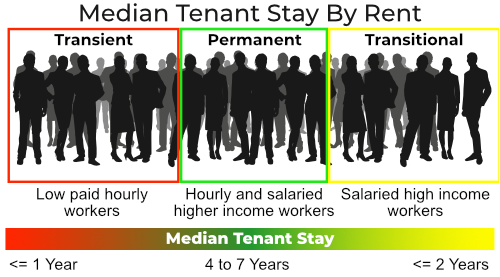
Comments on the three tenant pool segments:
- Transient - This tenant pool is primarily low-skilled hourly workers making little more than minimum wage. The typical renovation cost per turn is $1,500. The average tenant stay is one year. The average rent is $850/Mo. The average time to rent is eight weeks.
- Permanent - This tenant pool could be hourly or salaried, but they earn well above minimum wage. The typical renovation cost per turn is $500. The average tenant stay is five years. Typical rent $1,500/Mo. Typical time to rent, two to four weeks.
- Transitional - This tenant pool has a high enough income that they are typically home buyers. They typically only rent if there is a major negative event in their lives. For example, a divorce, the death of a spouse, just moved to town and wanted to rent for a year, etc. Once they sort out the problem, they will buy a home. The typical tenant stay is two years. The typical renovation cost per turn is $2,000. Typical rent $2,500/Mo. The typical time to rent is eight weeks.
Vacancy Cost for Different Tenant Pools
Vacancy cost is the sum of renovation cost plus carrying costs until another paying tenant is in place. Carrying cost is dependent on financing, taxes, insurance, and other property-specific costs. I will base the following example only on lost income due to vacancy over a ten-year period. To keep things simple, I will ignore inflation, rent increases, and similar variables. Below are the turn costs for each segment based on the above assumptions.

If I multiply Total Vacancy Cost by the 10 year turn frequency, I get the following:
- Transient: 10 turns x $3,200 = $32,000 or $3,200/Yr
- Permanent: 2 turns x $2,000 = $4,000 or $400/Yr
- Transitional: 5 turns x $7,000 = $35,000 or $3,500/Yr
As you can see, to have the same net cash flow from the three different segments, you need to have a far greater return from properties that target Transitional and Transient tenant pools than the Permanent tenant pool. For example, a 12% return from a Transient type property might generate the same net income as a 3% return from a Permanent type property.
There is another issue besides the tenant pool. Almost all multi-family properties in Las Vegas are over 40 years old and are located in high-crime areas. See the chart below.
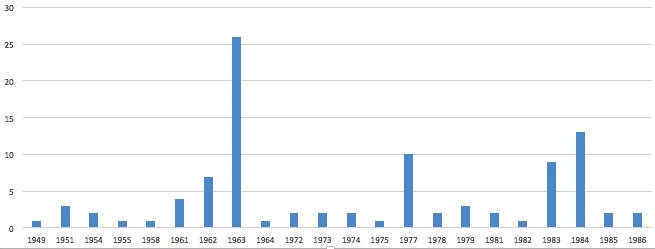
The newest multi-family property I am aware of was built in 1986. All the Las Vegas multi-family properties that I am aware of are in poor condition. Note that in some cases, the investor selling the property updated the interior. But, the cost to update the interior is nothing compared to replacing the aging infrastructure. For example, installing granite counters in a small unit is probably about $1500. Replacing the plumbing, which is usually falling apart, is $10,000 to $20,000. Replacing the roof is probably between $15,000 and $25,000.
A few people purchased these properties and updated them significantly, hoping they could raise the rent. It did not work. The problem is that anyone who can afford to pay more rent than the typical $850 a month would never choose to live in such a high-crime area.
There are excellent investment properties in Las Vegas, but C Class and most B Class properties are not the best options. Below are two charts showing how rents and prices increased over the last 12 months for properties that conform to our target tenant pool property profile.
Rentals - Median $/SF by Month
YoY increase of 18%.

Sales - Median $/SF by Month
YoY increase of 27%.

Long term performance of our tenant pool:
- 5 evictions in 15 years
- $500 average renovation turn cost
- Average tenant stay 5 years
- 2008 crash - Our clients had zero (no) decline in rent and no vacancies. In terms of rental income, 2008 was a non-event. However, property prices fell by 50% or more.
- COVID - Out of +200 properties, we have approximately five tenants who had to move out because they lost their jobs. I believe all paid an early release penalty of 1 to 3 months of rent. All the properties were re-rented in about one week for $100 to $300 more than before.
In summary, there are excellent properties in Las Vegas, but I do not recommend C Class or most B Class in general and multi-family in particular.
 Post: How do I buy my first rental property?
Post: How do I buy my first rental property?
- Realtor
- Las Vegas, NV
- Posts 737
- Votes 1,510
Hello @Nick Henry,
If your investment goal is an income stream that you can rely upon for many years to come, there are four steps you need to get right, which are illustrated below.

Location Selection
Location is the most important decision you will make, not the property. As long as you buy in a good location, all but the worst mistakes will be corrected over time through rent increases and appreciation. However, if you don't invest in a good location, there is little you can do to turn things around. So, you have to make the right location decision.
Fortunately, there are a few indicators that make selecting a good location easier than you might imagine. The most important of them all is the rate of appreciation.
- Appreciation - The number one criteria in location selection is appreciation. Inflation is constantly eroding buying power; each year, it costs more to buy the same set of goods. If you buy in a location where prices and rents are rising faster than the inflation rate, you will be able to buy the same set of goods because you will have the additional dollars you need from increased rents. If you buy in a location where prices and rents are increasing below the inflation rate, the buying power of your rental income will decrease over time.
- Population Size - Greater than 1 million. Small towns may rely too much on a single business or market segment.
- Population Growth - If people are moving into a location, many things have to be right, including jobs and cost of doing business. I would not invest in any location where the population is stagnant or declining.
- Crime - People and companies will not move to locations perceived as dangerous. One source of cities to avoid is Neighborhood Scout's 100 most dangerous cities.
- Disaster Risk - Some parts of the country are more prone to natural disasters. The best indicator for natural disaster probability is homeowners insurance cost. I would avoid states with high insurance rates. Note, even if insurance pays for all the damage your property suffers, you still lose. When a significant disaster occurs, people and jobs move to locations where they can make money today. The location may take years to recover, or it may never recover. ValuePenguin is a good source for the relative cost of insurance by state.
Investment Team
If you needed surgery, you would not start medical school. Also, not just any doctor will do. You want a surgeon that specializes in the kind of surgery you need, not a general practitioner. The same is true with real estate investing. You want to work with an investment team that already has the skills. Below is a list of the necessary skills. (You will need to click on the image to enlarge.)
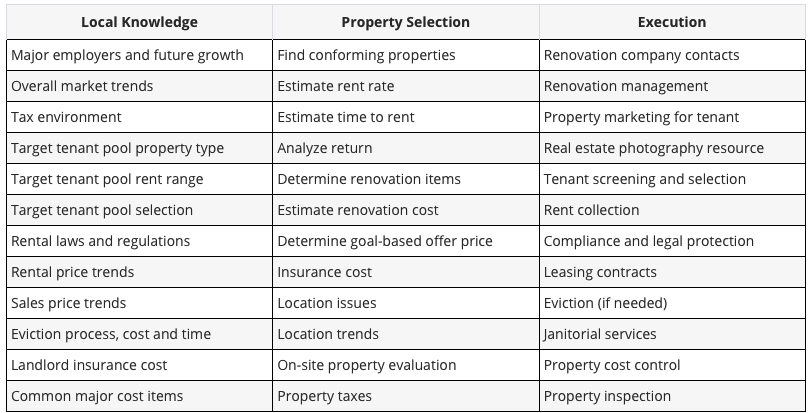
A good investment team will minimize your risk and save you time and money. If you try to do everything yourself, it will cost you more, and the odds of being successful are much lower. Do not make this mistake.
Good investment teams are hard to find. The place to start is with an investment Realtor. Know that even in a large metro area, there is likely only one or at most two investment Realtors. While finding an investment Realtor may take time, the cost, risk and time savings will be worth it.
Tenant Pool
The only way to consistently make money is to keep the property occupied by what I call a good tenant, who:
- Has stable employment in a market segment that is very likely to be stable or improve over time
- Has a credit history with which you can evaluate the likelihood that they will perform
- Pays all the rent on schedule
- Takes care of the property
- Does not cause problems with neighbors
- Does not engage in illegal activities while on the property
- Stays for many years
Good tenants are the exception, not the norm. Good tenants are the result of:
- Targeting the right tenant pool
- Selecting the right property
- A skilled property manager
How do you determine the right tenant pool that will support your financial goals? Your investment team will include a property manager in addition to an investment Realtor. They are your first stop. In addition, I would interview multiple property managers. I believe that the best tenant pool to target will be obvious once you go through the interviewing process.
Property Selection
If you select a property that matches your target tenant pool, most applicants are likely to come from your target tenant pool. With the right property, combined with a skilled property manager, your chances of getting a good tenant are high.
To know what to purchase, you need to understand how prospective tenants select a property. Tenants develop a shortlist by applying four filters, as illustrated below.
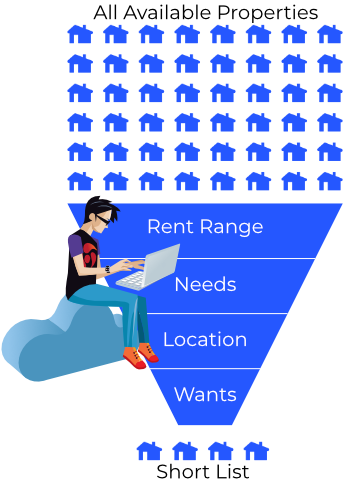
Working with your team, translate your tenant pool's rent range, needs, location, and wants into a physical description of properties that will match. I call the physical description a property profile. See the diagram below.

The minimum information a property profile contains is the following:
- Type: Condo, high rise, single-family, multi-family, etc.
- Price Range - You must be able to profitability rent the property within the target tenant pool's rent range.
- Location - Where the target tenant pool wants to live.
- Configuration: For example, 2,000SF, two bedrooms, three-car garage, large back yard, single-story, two stories, etc.
- Wants - Tenant pool specific property features. For example, bars on the first floor windows might be very important. For another tenant pool, it might be granite kitchen counters.
Your investment team will find properties that conform to the property profile and provide the information you need to make an informed decision, which includes:
- Candidate properties
- Rent
- Time to rent
- ROI/Cash flow
- Renovation items - The items that must be changed in order to attract the target tenant pool.
- Estimated renovation cost
Note that an MLS data sheet contains none of the above information. MLS data sheets are excellent for home buyers but not for investors.
With the above information, combined with what you learned about the target tenant pool's vacancy cost, you have what you need to make an informed decision on property selection.
Summary
Nick, if you follow the above process, your odds of consistently buying properties that perform in good times and bad are very high.
 Post: Found a property in LV but worried about peak
Post: Found a property in LV but worried about peak
- Realtor
- Las Vegas, NV
- Posts 737
- Votes 1,510
It's been a while since I posted an update on what we are seeing in Las Vegas. Note that the following only applies to the property profile we target.
Rentals - Median $/SF by Month
YoY rents are up 18%!

Sales - Median $/SF by Month
YoY prices are up 27%!

Sales - Months of Supply
6 months of inventory is considered a balanced market. Today we are at about 0.6 months. And, until inventory rises significantly, I do not expect prices to level off, let alone decline.

So, things are going very well for Las Vegas investors. Below is how our target tenant pool performed over the long run:
- Average Annual Appreciation - An average of 9% since 2013. More now since 2021 saw a large price increase.
- 2008 crash - Our clients had zero (no) decline in rent and no vacancies. In terms of rental income, 2008 was a non-event. However, property prices fell by 50% or more.
- COVID - Out of +200 properties, we have approximately five tenants who had to move out because they lost their jobs. I believe all paid an early release penalty of 1 to 3 months of rent. All the properties were re-rented in about one week for $100 to $300 more than before.
- 5 evictions in 15 years
- $500 average turn renovation cost
- Average tenant stay is 5 years
The Foreseeable Future
Demand is what drives prices. So, what is driving demand in the Las Vegas metro area?
- Jobs - Las Vegas fully recovered in the first month everything reopened. "Help Wanted" and job fairs are just about everywhere. Thousands of new jobs are being created as well. Today, there is about $20B in new construction, and another $5B to $7B has been announced. This new construction will create tens of thousands of additional jobs, which will result in more people moving to Las Vegas. More people will increase demand, which will increase prices and rents.
- California Exodus - Almost every day, I read another article about companies and people fleeing California. A percentage of the people fleeing California come to Las Vegas. This is especially true with the digital nomads. As more Californians flee, demand will continue to increase, which will increase prices and rents.
- Pro Business Environment - Nevada has no state income taxes, low property tax, low-cost property insurance, reasonable traffic, reasonable property prices, and lower cost of just about everything. Las Vegas is investor-friendly. Evictions take less than 30 days and cost about $500.
- Low commercial energy cost - California commercial energy rate: $.2275/kWh. Nevada: $.1114/kWh. California is over twice as expensive. Also, Las Vegas is one of the few cities in the US with dual sources of electric power, critical for electricity-dependent industries like data centers and manufacturers.
- Prices Remain Below Peak Prices - If you ignore inflation, prices are back to peak 2006 prices. If you believe inflation exists, we are still about $64/SF below peak prices.
- Land shortage - Las Vegas is an island surrounded by federal land. At the end of 2019, the amount of vacant buildable land in the Las Vegas Valley was less than 28,000 acres, of which 5,000 to 7,000 acres is not viable for residential development. (87.5% of Clark County is federally owned. 85% of the entire state is federally owned.) Consumption rate is about 5,000 acres/year. See the animated GIF below. The areas in brown are federal land. The time-lapse only goes through 2018, and there was a large amount of development in 2020 and 2021. The shortage of land combined with the increasing population almost guarantees property prices and rent will continue to increase.
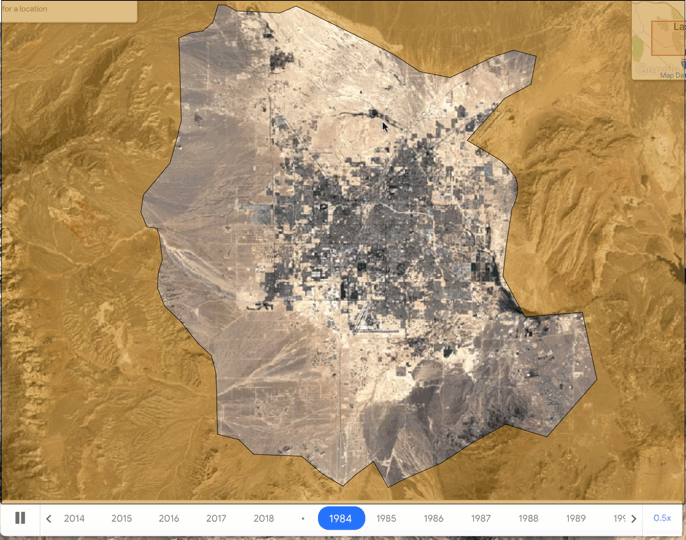
- Overall Las Vegas Single Family Inventory - Below is a chart showing months of inventory for all single family homes, not just the segment we target. As you can see, inventory is still declining so prices will continue to increase.

Summary
Based on what I see, the foreseeable future looks great for Las Vegas buy and hold investors.
 Post: Investing in Las Vegas
Post: Investing in Las Vegas
- Realtor
- Las Vegas, NV
- Posts 737
- Votes 1,510
Hello @Rafal Soltysek,
There are good properties available, but they are not common - YoY appreciation for properties that conform to our target tenant pool: 27%. YoY rent increase, 18%. See the charts below. What do I call good properties? Below is how our clients' and our properties performed over the last 15 years:
- Average annual appreciation since 2013: >9%. More now since 2021 saw a large increase.
- 2008 crash - Zero decrease in rent, no vacancies. Property prices fell like every other property, but no decrease in rent.
- COVID - Out of +200 properties, about five tenants could not pay the rent and vacated, paying one to three months penalty for early lease termination. The properties were re-rented in one to two weeks for $100 to $300 per month more.
- The eviction moratorium had no impact on our clients. Total evictions in 15 years: 5.
- Average tenant stay: 5 years
- Average turn renovation cost: <$500
Where do we find most of our properties? Below is a map showing a sample of our client's properties and the general area where our software finds the most conforming properties. The green shaded area is where our software finds the most conforming properties. However, while the shaded area looks homogeneous, in reality, it looks more like Swiss cheese.
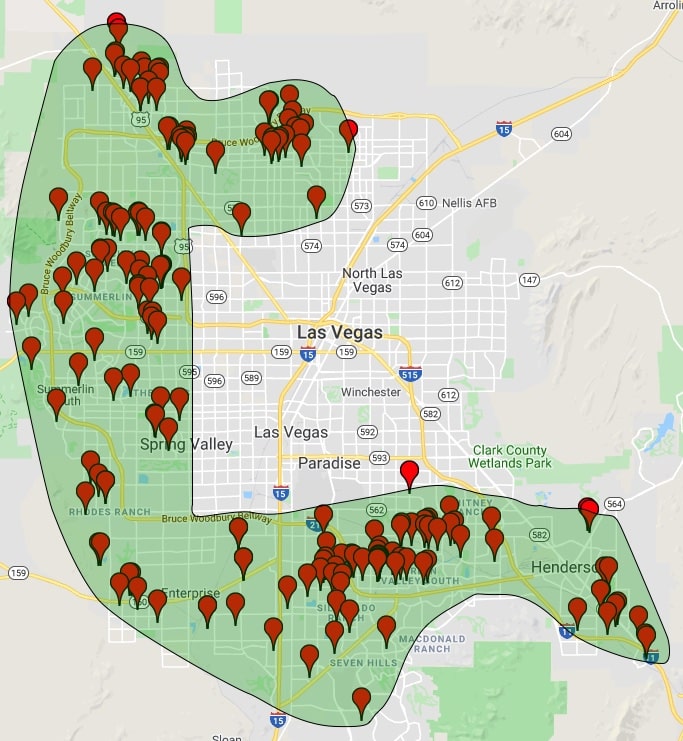
What is the current market situation for conforming properties? Below are trailing 13 month statistics:
Rentals - Median $/SF by Month
Rent is up 18% YoY.

Sales - Median $/SF by Month
Prices are up 27% YoY

Sales - Months of Supply
This is no bubble. There is only 0.5 or 0.6 month of supply since March 2021. Demand is far greater than supply.

Why Will Las Vegas Continue to Perform?
The two big factors driving demand are increasing population and tens of thousands of new jobs.
- California - People and companies continue to flee California and a percentage choose Las Vegas.
- >$20B in new construction under development and several billion more announced. This will create tens of thousands of good jobs bringing more people to Las Vegas.
- No state income tax.
- Property tax average is 0.55%
- Landlord insurance on a $420,000 property is $550/Yr.
Conditions for Success:
- The right tenant pool - Not all tenant pool perform equally well. Vacancy cost being the biggest cost difference.
- The right local investment team - You cannot learn all you need to know and find all the resources you need on your own. And, working with an investment team costs you nothing. Failing to work with a good investment team will cost you time, money and risk.
- The right property - You must select properties that attract the right tenant pool and have low maintenance costs.
Summary
There are good properties available today. The conditions increasing demand are real and driven by new jobs and people fleeing California. We see no reason for this to change for the foreseeable future.
 Post: New investor - Advice on Brrr’ing in Las Vegas Market
Post: New investor - Advice on Brrr’ing in Las Vegas Market
- Realtor
- Las Vegas, NV
- Posts 737
- Votes 1,510
Hello @Kevonna Ahmad,
We have clients (and we) use the BRRRR method. However, buying a property significantly below market value, renovate, refinance and repeat will probably not work. Demand is outstripping supply significantly, so few (good) properties are to be had at a discount. However, due to rapid appreciation (27% YoY) you can refinance them fairly quickly. Below are two charts showing how properties that conform to our property profile performed over the last 13 months.
Sales - Median $/SF by Month
27% YoY appreciation.

Sales - Months of Supply
Six months of supply is considered a balanced market. Currently, conforming properties are at about 0.6 months of supply. The limited supply of properties is what makes finding properties at a discount unlikely. Also, the limited supply is a clear indication that this is not a bubble. While we may not see 27% annual appreciation rates in the future (I hope not), I believe prices will continue to rise rapidly, which works well for BRRRR. Let me know if you would like a BRRRR case study.

Rentals - Median $/SF by Month
Rents are also rising rapidly. YoY increase of 18%! This means that even with the rapid price increase, you will still receive a good initial return and expect your return to growing as rents increase.

I hope the above helps.
 Post: Buying Rentals Out Of State Without Turnkey Companies
Post: Buying Rentals Out Of State Without Turnkey Companies
- Realtor
- Las Vegas, NV
- Posts 737
- Votes 1,510
The advantage "experts" have is that they are always right somewhere at some time. However, they are rarely correct in any specific location at any given time. Las Vegas is just such a location. Below is a comparison between 2008 and today, what we are seeing, and what will continue to drive the Las Vegas market for the foreseeable future.
2008 vs. Today

I see no similarity, despite the fear mongers in the press. Of course, fear sells, no one buys good news.
What We Are Seeing
Below is 13 month trailing statistics on all single family properties that conform to our property profile. Our property profile defines properties that our target tenant pool is willing and able to rent.
$/SF Rental Rate

Rental Monthly Inventory
Around 3 months of inventory is typical for this time of the year. Today, it is 0.4 months.

$/SF Sales

Sales Inventory by Month

I think you will agree that there is little to indicate a crash. The question is, will it continue? In my opinion, yes. Perhaps (hopefully) not at the current fevered pitch.
What I Expect in the Foreseeable Future
Demand is what drives prices. So, what is driving demand in the Las Vegas metro area?
- Jobs - Today, there is about $20B in new construction, and another $5B to $7B has been announced. This new construction will create tens of thousands of additional jobs, which will result in more people moving to Las Vegas. More people will increase demand, which will increase prices and rents.
- California Exodus - Almost every day, I read another article about companies and people fleeing California. A percentage of the people fleeing California come to Las Vegas. This is especially true with the digital nomads. As more Californians flee, demand will continue to increase, which will increase prices and rents.
- Pro Business Environment - Nevada has no state income taxes, low property tax, low-cost property insurance, reasonable traffic, reasonable property prices, lower cost of just about everything. Las Vegas is investor-friendly. Evictions take less than 30 days and cost about $500. For our target tenant pool, we've had five evictions in the last 15 years. California commercial energy rate: $.2275/kWh. Nevada: $.1114/kWh. California is just over twice as expensive.
I could continue, but I think you can see that Las Vegas is a desirable place to live, especially when compared to California.
Risks
- Water - Today, between 70% and 80% of all water consumption is wasted on grass. It makes no sense to grow grass in the desert. If the situation becomes dire, implement a progressive water charge. Lawns will disappear rapidly. Alternatively, Las Vegas is about 300 miles away from a major source of water in northern Nevada. Almost all the land between Las Vegas and the water sources is federal, so minimal cost. The Keystone pipeline was 1,200 miles and crossed several states, and was mostly on private or reservation land, and is projected to cost $5.7B. The most recent casino to open cost over $7B. The last estimate I heard for building the Las Vegas water pipeline was $2B. However, whether the cost is $2B, $10B, or $20B does not matter. Las Vegas is not going to be shut down due to water.
- Californication - This is a valid concern. People flee California due to regulations, and costs and then want to implement the same disastrous conditions in Nevada. Fortunately, it seems that after about a year, they lose the "California" mindset. So, this may not be a valid concern.
My Opinion
Las Vegas is doing well today and is very likely to do well into the foreseeable future. What am I personally doing? I am adding more properties to my portfolio.
